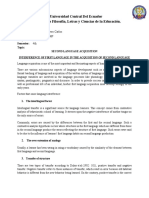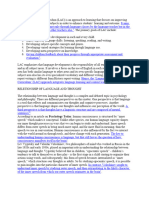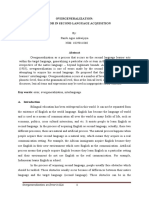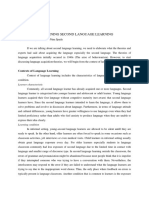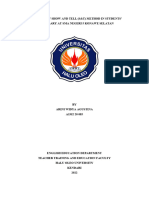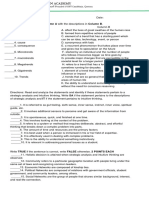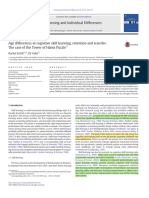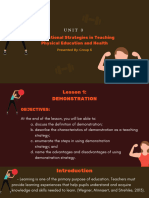0 ratings0% found this document useful (0 votes)
4 viewsENGL 321: Acquisition of Second Language
ENGL 321: Acquisition of Second Language
Uploaded by
sharonsimiyu59Copyright:
© All Rights Reserved
Available Formats
Download as PPTX, PDF, TXT or read online from Scribd
ENGL 321: Acquisition of Second Language
ENGL 321: Acquisition of Second Language
Uploaded by
sharonsimiyu590 ratings0% found this document useful (0 votes)
4 views57 pagesOriginal Title
Sla
Copyright
© © All Rights Reserved
Available Formats
PPTX, PDF, TXT or read online from Scribd
Share this document
Did you find this document useful?
Is this content inappropriate?
Copyright:
© All Rights Reserved
Available Formats
Download as PPTX, PDF, TXT or read online from Scribd
Download as pptx, pdf, or txt
0 ratings0% found this document useful (0 votes)
4 views57 pagesENGL 321: Acquisition of Second Language
ENGL 321: Acquisition of Second Language
Uploaded by
sharonsimiyu59Copyright:
© All Rights Reserved
Available Formats
Download as PPTX, PDF, TXT or read online from Scribd
Download as pptx, pdf, or txt
You are on page 1of 57
ENGL 321
ACQUISITION OF SECOND LANGUAGE
INTRODUCTION
THE STUDY OF SECOND LANGUAGE ACQUISTION
Aims at describing and explaining the development and non
development of languages and language varieties beyond the
first language.
It is also known as SLA.
It focuses on children and adults learning a second language
naturalistically or with the aid of formal instruction as
individuals or groups
LANGUAGE LEARNING VS. ACQUISITION
LANGUAGE ACQUISITION
This involves the gradual development in the ability to use a
second language by constantly using naturally in
communication situations.
It involves mastering a set of rules of grammar of a language
so as to form complete and meaningful sentences.
In acquisition meaning and form must be taken together, no
one can go before the other.
Acquisition is innate and uses the language faculty in the brain.
Activities associated with acquisition are normally encountered
by the young child through language use and interaction
LANGUAGE LEARNING VS. ACQUISITION
LANGUAGE ACQUISITION
Overt instruction is important in language acquisition, children
require to interact with other language users in order to bring
the faculty into operation.
Acquisition is thus a sub-concious and a natural process.
LANGUAGE LEARNING VS. ACQUISITION
LANGUAGE LEARNING
This refers to the conscious process of accumulation of
knowledge of vocabulary and grammar of the language.
Language learning involves a series of conscious attempts at
imitation which are reinforced when correct and eliminated
when deficient.
Activities associated with learning have been used in language
teaching in schools and they tend to result in knowledge about
the language.
LANGUAGE LEARNING VS. ACQUISITION
LANGUAGE LEARNING
Learning involves a relatively permanent change in behaviour
as a result of reinforced practice.
LANGUAGE LEARNING VS. ACQUISITION
CONCEPTS AND TERMINOLOGIES IN LANGUAGE AND
ACQUISITION
COMPETENCE
is a knowledge system of rules that govern the use of a particular
language.
It also refers to the knowledge of an infinite number of sentences and
utterances and how to use them in different situations.
PERFORMANCE
Refers to the concrete act of speaking or signing .
It refers to the use of this infinite number of utterances and signs that
some of them have never been heard before.
Performance is th linguistic behaviour in itself.
CONCEPTS AND TERMINOLOGIES IN LANGUAGE AND
ACQUISITION
FIRST LANGUAGE
A language that a child is exposed to first .
It is also called a mother tongue
SECOND LANGUAGE
Refers to a language other than mother tongue which is use d
for special purposes.
It has a special social function and is occurs in multilingual
states e.g. the use of English in Kenya.
CONCEPTS AND TERMINOLOGIES IN LANGUAGE AND
ACQUISITION
FOREIGN LANGUAGE
A language learned after the 1st language but with no special
status .
It is not the mother tongue of any one group within the speech
community.
It usually serves no internal communication function
It only serves the to ease communication with members of the
target a language in or outside the country.
APPLIED LINGUISTICS AND SLA
The academic discipline of language learning and
acquisition is a sub-discipline of applied linguistics.
Applied linguistics is the study of language and
language related problems in specific situations where
people use and learn languages.
Applied linguistics is an interdisciplinary field of study
that identifies, investigates and offers solutions to
language related real life problems.
Some of the academic fields that are related with
applied linguistics include: education, linguistics,
psychology, anthropology and sociology.
APPLIED LINGUISTICS AND SLA
As a field of linguistics it looks at the wider areas of
language assessment, language policy and second
language acquisition.
IMPORTANCE OF APPLIED LINGUISTICS IN THE
ACQUISITION OF A SECOND LANGAUGE
Applied linguistics looks at how people acquire language and
how they can be taught better.
It aims at improved language teaching by undertaking a vigorous
study of language.
It employs other fields of knowledge such as psychology, testing
and measurements, language education in the teaching and the
learning of a second language.
It increases our knowledge of acquisition of second language by
testing hypothesis on language learning and acquisition theories.
It helps in the development of language learning and language
teaching methodologies as well as materials.
QUALITIES NECESSARY FOR SECOND LANGUAGE
ACQUISITION
ACCESS/ EXPOSURE
For successful SLA to take place the learner has to be exposed to the language, this means
there has to be contact between the learner and the language. Accessibility to the language
can be achieved through:
Natural/social circumstance: this occurs in a bilingual or a multilingual situation whereby one
is exposed to the second language naturally.
It occurs among children born to parents with different first languages, migrants, tourists,
refugees etc.
Educational instruction: this exposure may be voluntary or mandatory educational exposure.
It may occur in the following forms:
Immersion: learners with fluency in their first language and having no prior contact with the
first language are put together in a classroom and the second language is used as a medium
of instruction.
Submersion: 2nd language users are taught in a class where the majority are native second
language speakers
QUALITIES NECESSARY FOR SECOND LANGUAGE
ACQUISITION
STRUCTURE OF THE LANGUAGE
If the structure of the second language is almost similar to the structure of the
first language then acquisition becomes easier and faster
PROPENSITY OF THE LANGUAGE LEARNER TO LEARN
This involves a totality of factors which induce the learner to use his
language faculties to earn the language.
Effort expended in learning the language will depend on the following:
I. Role played by the language in society
II. Ego permeability i.e. an individuals preparedness to reveal their imperfect
command of the second language. IT also refers to a learners
preparedness to readily reveal their imperfect command of the second
language and their readiness to degrade oneself in inappropriate, awkward
or ridiculous situations
QUALITIES NECESSARY FOR SECOND LANGUAGE
ACQUISITION
LEARNING CAPACITY OF THE LEARNER
This is based on the learning capacity of the brain which enables all
humans to acquire language naturally. It varies naturally with
individuals.
In second language acquisition, the younger the learner the easier it
is especially from infancy to puberty.
THE RATE OF ACQUISITION OF THE LANGUAGE
The more successful the second language learners are the more
motivated they are to learn
The second language learner who is encouraged on his/her success
and accomplishments learns faster than the learner who merely
undergoes formal grammatical instruction.
LANGUAGE LEARNING THEORIES
BEHAVIOURISTIC THEORY
This theory considers it inappropriate to speculate about what
goes in the brain during language learning.
This theory limits its attention to overt actions and ways in
which other people such as parents, teachers or peers can
influence this action.
For behaviorists, language learning takes place when there is
evidence of overt change in ones behaviour. This evidence
ought to be observable.
The data for behaviorists is the utterances made and the
conditions under which they are made.
LANGUAGE LEARNING THEORIES
BEHAVIOURISTIC THEORY
This theory states that every utterance made or part of it
is produced as a result of the presence of a stimulus.
The utterance in this case is a result of the presence of a
stimulus.
The stimulus can be physically present in the learning
situation i.e. it may be verbal, where a language is
produced in response to another language or it may be
non verbal e.g. a call of nature or a state of thirst.
These may stimulate the learners to make a verbal
response.
LANGUAGE LEARNING THEORIES
BEHAVIOURISTIC THEORY
This theory emphasizes on the importance of
reinforcement in the learning process.
According to the theory a learner must be
continuously reinforced through reward, punishment,
approval and disapproval.
For behaviorists, language learning takes place when a
learner emits response, however in language learning
a repetition of this response is necessary for full
learning.
LANGUAGE LEARNING THEORIES
BEHAVIOURISTIC THEORY
This theory also calls for continuous active use of language by
a child, this leads to proper language learning.
According to this theory, the correct responses should be
reinforced while the incorrect ones should be discouraged.
Meaning for behaviorists, refers to the ability to produce an
appropriate response from a stimulus.
This theory also states that the learners of a language make
sentence structures based on the structures and habits learnt
and heard from adults through imitation.
LANGUAGE LEARNING THEORIES
BEHAVIOURISTIC THEORY
Skinner(1977) came up with positive behaviorism.
He introduced the operant behaviour and respondent
behaviour.
Skinner emphasized on the beneficial effects of immediate
reinforcement.
He insisted that the desired behaviour is effectively acquired
by rewarding successively.
According to skinner, learning is made up of a collection habits
that children learn by simply imitating those around them
CONTRASTIVE ANALYSIS THEORY
C.A refers to the systematic comparison of the specific
linguistic characteristics of two or more language chosen
for comparison.
In language learning, the two languages chosen for comparison
usually is the learners mother tongue( L1) and the target
language (L2).
The main function of CA is to predict the likely errors of a
group of learners and use it to provide the linguistic input to
language learning materials. l/r- f/v – d/t –k/g
If contrastive analysis of two languages is carried out the
differences between the languages can be established for the
purposes of predicting likely learner difficulty.
CONTRASTIVE ANALYSIS THEORY
The main terms in CA usually are transfer and
interference.
When the first language(L1) habits aid in the
acquisition of L2 features then this is called positive
transfer. This happens for example when two languages
share a similarity in the sentence or sound structure.
Native bantu speakers learning Swahili benefit from
positive transfer
When the L1 language habits interferes in the learning
of the new patterns of L2 then we talk of interference or
negative transfer.
CONTRASTIVE ANALYSIS THEORY
Contrastive analysis plays two main roles in language
learning:
i. predicting problems in language learning
ii. Development of course materials for language learning
STEPS IN CARRYING OUT CONTRASTIVE ANALYSIS
i. Carrying out a CA of the two languages at all levels of
linguistic analysis
ii. Simplifying the analysis
iii. Converting the simplified results into classroom materials
iv. Classifying the errors in surface taxonomies relevant to the
layman
CONTRASTIVE ANALYSIS THEORY
WEAKNESSES OF CONTRASTIVE ANALYSIS THEORY
The relations between the psychological and linguistic aspects
may be difficult to explain or one cannot sort out psychological
errors from linguistic errors.
The relations between CA and real classroom situation is
difficult to establish.
It is not easy to convert CA data into classroom data.
Detailed descriptions of the languages are necessary in CA
and yet in they are impracticable. 40 minutes
ERROR ANALYSIS THEORY
This theory views errors in language learning very
positively.
Error analysis is alternate view to contrastive analysis
Error analysis thus:
i. Tells the language teacher what progress the learner has made and
what is still missing: tenses, spelling, sentence
ii. Provides a researcher with information on the strategies in
language acquisition: simplification, overgneralization, avoidance,
transfer
iii. Errors are seen as devices that the learner use to acquire gradual
competence in the L2.
ERROR ANALYSIS THEORY
THE CONCEPT AND TYPES OF ERRORS IN
LANGUAGE LEARNING
An error in language learning is a permanent feature of
misconstruction that the learner cannot correct.
I caught the thief in the act
Errors are based on competence and therefore are permanent.
A mistake in language learning is not permanent but rather
performance based and as such they are spontaneous and not
systematic.
In the language learning situation, learners make both
comprehension and production errors.
THE CONCEPT AND TYPES OF ERRORS IN LANGUAGE
LEARNING
An example of a comprehension error is when a
learner misunderstands the sentence:
Pass me the pepper
For
pass me the paper
This will arise due the learners inability to
comprehend the distinction in the sounds /e/ and /ei/
as employed distinctively in the two words.
A production error would be:
The worst thing she did was to cheat on me
A DISTINCTION BETWEEN ERRORS AND MISTAKES IN LANGAUGE
LAEARNING
An error occurs when the deviation occurs as result of lack of knowledge. The
mechanic repairs cars at the garage
Mistakes occur when the learners fail to perform their competence.
These are also called processing problems that prevent the learner from accessing
their knowledge of the target language.
The same may cause the learner to fall back on some alternative non standard
rule that they find easier to understand.
Mistakes are a result of memory limitations and lack of automicity in the learner.
Mistakes can be identified and corrected by the learner with a lot ease.
Learners are not able to identify nor correct their errors due to lack of knowledge.
Mistakes are spontaneous and not systematic
Errors are very frequent and follow a systematic pattern: spelling errors,
grammatical errors, punctuation, choice of words
Errors are permanent / mistakes are not permanent
TYPES OF ERRORS IN LANGUAGE LEARNING
PERFORMANCE ERRORS:
These are errors made by the learners when they are tired or
exhausted.
These mistakes are not serious and can be overcome by the
learner with little effort.
COMPETENCE ERRORS
Richards (1971) distinguishes two types of such errors:
Interference errors:
These errors occur as a result of the use of elements from one
language to another. They are also referred to as: interlingual
errors. Bus/ mbus
I eat/ take my porridge/soup
TYPES OF ERRORS IN LANGUAGE LEARNING
Intralingual errors
They reflect general characteristics of rule learning such as
faulty generalizations and incomplete application of rules
and failure to learn how the rules apply. E.g. baddest,
womans, sheeps, knowing etc
S to mark the plural
DEVELOPMENT ERRORS
I don’t know nobody
They occur when the learner attempts to build hypothesis
about the target language on the basis of limited
experience.
OVERGENERALIZATION AND TRANSFER IN LANGUAGE
LEARNING
LANGUAGE TRANSFER
This is also known as first language interference or mother tongue
interference.
It involves learners who apply knowledge from their native languages
to a second language.
Language transfer may take the following forms:
Positive transfer:
Occurs when the relevant structure or unit transferred from the
relevant languages is the same.
The interference in this case aids in the acquisition of the relevant
structure in the L2. speakers of English and German
Positive transfer thus results in the production of the correct L2
output
OVERGENERALIZATION AND TRANSFER IN LANGUAGE
LEARNING
Negative transfer:
This kind of interference is mostly caused by the transfer of non
desirable elements from the first language to the second language.
In this case the L1 is a source of errors in the second language
output. These Errors cut across all levels of linguistic analysis
Open the radio/ kunywa uji. whom did you see?
It is worth to note that the greater the difference between the two
languages the greater the negative transfer.
The more similar the two languages are then the more the positive
transfer.
Positive transfer would be cited for Anglophone learners of
German.
OVERGENERALIZATION AND TRANSFER IN LANGUAGE
LEARNING
OVERGENERALIZATION/ exceptions: bad/dest, the goodest,
there was no one around.
This a form of error in L2 learning where learners use rules from
the second language in a way that the native speaker would not.
E.g. I goed
the goodest
It involves over-regularization or the extension of regular
grammatical patterns to irregular words.
Ed/d to express the past tense camed/goed/ swimmed/ teached
e.g. I feeled, mouses, sheeps, drinking porridge etc
childrens
FORMS OF SIMPLIFICATION AS LEARNING STRATEGY IN
LANAGUAGE LEARNING
SIMPLIFICATION
Simplification is a process where learners of a l2 use a very simplified
structure of the l2 almost similar to the language of a pidgin or the
language of a small child.
FORMS OF SIMPLIFICATION IN ENGLISH LANGUAGE
Omission of simple present tense third person singular inflection. E.g.
he play everyday
she sing everyday at the assembly
Omission of simple past tense inflection
He play yesterday
The bus crash at the cliff last night
FORMS OF SIMPLIFICATION AS LEARNING STRATEGY IN
LANAGUAGE LEARNING
FORMS OF SIMPLIFICATION IN ENGLISH LANGUAGE
Omission of auxiliaries and inversion in questions.
See peter today?
“Peter come today? “, he asked me.
You my uncle?
Simplification of syllables through vowel insertion and
deletion.
Friday – furahide
School – sukul/ sukuru
Deletion of English articles
FORMS OF SIMPLIFICATION AS LEARNING STRATEGY IN
LANAGUAGE LEARNING
FORMS OF SIMPLIFICATION IN ENGLISH LANGUAGE
Semantic simplification
Involves use of base forms to cover deficiencies at the
vocabulary level.
e.g.
Any liquid is drank
INTERLANGUAGE THEORY
The concept of an interlangauge was introduced by
Selinker in 1972.
It assumes that the learners errors are very important for
their development of competence in a second language.
the interlangauge therefore is an interplay in the
structures of the L1 and the L2 in the learning process.
This interplay assures the learner of his progress in second
language development.
An interlangauge thus is a step in the development of
second language competence.
INTERLANGUAGE THEORY
The idea of an interlangauge is founded upon the assumption that
a second language learner at some point in the learning process
are using a language system which is neither the L1 nor the L2.
It is a language with its own system , which is neither the L1, nor
the L2 but rather it is a third language with its own grammar, its
own vocabulary , phonology etc.
The rules used by the learners in an interlangauge are not found
in their mother tongue and the second language.
The lesson to be learn fro an interlangauge as suggested by
applied linguists such as Pitt Corder, Nemser and Selinker is that
we need to understand the learner’s language as a system in its
own right.
INTERLANGUAGE THEORY
According to Selinker a learner creates his interlangauge through
number of processes, these are also called learning strategies.
Language transfer: the learner uses her own as a resource, this
happens when the learners fall back to their on their mother
tongues especially in the early stages of language development.
Overgeneralization: the learners uses L2 rules in situations
which a native speaker would not , these can occur at all levels of
linguistic levels of analysis.
Simplification: occurs at syntactic, phonological and semantic
levels. The learners at this level use a very simplified language
structure almost similar to the language of children or pidgins.
INTERLANGUAGE THEORY
Avoidance: the learners uses all means possible to avoid using
structures from the L2 which they find difficult to master due
to a huge disparity in their structure from what is the case in
their first language.
Over-use: the learners uses structures they are very
comfortable with from the second language instead of
attempting new and novel expressions in the language.
Fossilization : may occur during the interlangauge period.
Fossilization occurs when the learner ceases learning a
language before they reach target language norms.
These happens inspite of the student receiving continuous L2
input with the passage of time.
INTERLANGUAGE THEORY
Fossilization :
This phenomena is normally associated with older L2
learners.
It is the normal cause of a foreign accent in language
learning.
This stage is also called the end state i.e. a state where
learning a learner stops learning.
There are two aspects of fossilization:
selectivity or lack of new items
Backsliding or falling down to original forms even when
new items in the L2 have been introduced
INTERLANGUAGE THEORY
CHARACTERISTICS OF AN INTERLANGUAGE
Systematic: an interlangauge is governed by rules from the
learners L1 and the L2.
Dynamic: it changes frequently with time
Variable: Based on context and situation
Reduced system: ( form) the interlangauge is less complex
grammatically. pidginized
Reduced system: (function) only used for a small range of
communicative activities
UNIVERSAL HYPOTHESIS
This is a theory also called innatism or mentalist theory.
It is associated with Noam Chomsky
It claims of an innate ability for language acquisition in
human beings.
According to the theory human beings are genetically
preprogrammed to learn language.
The assertion that human beings are genetically
preprogrammed to learn language is backed by the
following assertions
UNIVERSAL HYPOTHESIS
The structure of human organs:
The human vocal apparatus is specifically designed for
language functions
To communicate orally this theory states that we need both
an appropriate vocal apparatus as well as a brain capable of
processing a huge amount of linguistic data.
In human beings we can identify a language centre in both
hemispheres of the brain this is within the plenum temporal.
In 94% of people the part of the brain known as the
Wernickes Area situated within the Planum temporalle is
larger in the left hemisphere than in the right hemisphere
UNIVERSAL HYPOTHESIS
In this group of people the left hemisphere is the dominant
side for language.
In addition to this language processing part of the brain the
human auditory system is adept at the processing of
auditory signals.
The human auditory perception is genetically
preprogrammed and indicate an innate preparedness to
learn language.
UNIVERSAL HYPOTHESIS
The speed of acquisition of language
Innatists argue out that the staggering rate with which
children acquire language can only be explained if we
assume that human beings are genetically preprogrammed
for language functions.
This theory claims that children do not just come to
language learning with an blank mind but with an innate
disposition for language learning.
UNIVERSAL HYPOTHESIS
Language is unique to humans
The human compulsion to communicate is manifest in
language.
Some theorists have claimed that language can only be
used by humans .
Attempts to teach language to other animals have been
made and the most success has been achieved with
chimpanzees.
While apes are able to learn some aspect of language, the
process is extremely slow and laborious.
UNIVERSAL HYPOTHESIS
Linguistic universals
Innatists argue out that whilst human languages have
different rules of grammar they also many things in
common.
These language similarities are also called linguistic
universals.
Absolute universals are statements that are unequivocally
true for all natural languages.
For example all languages are: learned, rule governed, all
language s have consonants and vowels, all languages have
pronouns etc.
UNIVERSAL HYPOTHESIS
Linguistic universals
The presence of these linguistic universals makes it
possible for human beings to learn any language.
Chomsky refers to the child’s innate general language
learning ability as LAD.( language acquisition device)
It claims that children have a blue print in the brain that
allows them to recognize the structure dependence of
language.
UNIVERSAL HYPOTHESIS
Linguistic universals
The presence of these linguistic universals makes it
possible for human beings to learn any language.
Chomsky refers to the child’s innate general language
learning ability as LAD.( language acquisition device)
It claims that children have a blue print in the brain that
allows them to recognize the structure dependence of
language.
THE MONITOR MODEL
The input hypothesis, also known as the monitor
model, is a group of five hypotheses of
second-language acquisition developed by the linguist
Stephen Krashen in the 1970s and 1980s.
Krashen originally formulated the input hypothesis as just
one of the five hypotheses, but over time the term has come
to refer to the five hypotheses as a group.
The hypotheses are the input hypothesis, the
acquisition–learning hypothesis, the monitor
hypothesis, the natural order hypothesis and the
affective filter hypothesis.
THE MONITOR MODEL
The input hypothesis. This states that learners progress in their
knowledge of the language when they comprehend language
input that is slightly more advanced than their current level.
Krashen called this level of input "i+1", where "i" is the learner's
interlanguage and "+1" is the next stage of language acquisition.
'Comprehensible input' is the crucial and necessary ingredient
for the acquisition of language.
The acquisition–learning hypothesis claims that there is a
strict separation between acquisition and learning; Krashen saw
acquisition as a purely subconscious process and learning as a
conscious process, and claimed that improvement in language
ability was only dependent upon acquisition and never on
learning.
THE MONITOR MODEL
The monitor hypothesis
The monitor hypothesis asserts that a learner's learned system acts
as a monitor to what they are producing.
In other words, while only the acquired system is able to produce
spontaneous speech, the learned system is used to check what is
being spoken.
Before the learner produces an utterance, he or she internally scans
it for errors, and uses the learned system to make corrections.
Self-correction occurs when the learner uses the Monitor to
correct a sentence after it is uttered.
According to the hypothesis, such self-monitoring and self-
correction are the only functions of conscious language learning
THE MONITOR MODEL
The natural order hypothesis states that language is
acquired in a particular order, and that this order does not
change between learners, and is not affected by explicit
instruction.
The natural order hypothesis states that all learners acquire a
language in roughly the same order.
This order is not dependent on the ease with which a
particular language feature can be taught; some features,
such as third-person "-s" ("he runs") are easy to teach in a
classroom setting, but are not typically acquired until the
later stages of language acquisition.
THE MONITOR MODEL
The affective filter hypothesis.
The affective filter is an impediment to learning or
acquisition caused by negative emotional ("affective")
responses to one's environment. It is a hypothesis of
second-language acquisition theory, and a field of interest
in educational psychology and general education.
THE MONITOR MODEL
The affective filter hypothesis.
According to the affective filter hypothesis, certain
emotions, such as anxiety, self-doubt, and mere boredom
interfere with the process of acquiring a second language.
THE MONITOR MODEL
The affective filter hypothesis.
They function as a filter between the speaker and the
listener that reduces the amount of language input the
listener is able to understand.
These negative emotions prevent efficient processing of
the language input.
The hypothesis further states that the blockage can be
reduced by sparking interest, providing low-anxiety
environments, and bolstering the learner's self-esteem.
You might also like
- Linguistic and Literacy Development of Children and AdolescentsDocument37 pagesLinguistic and Literacy Development of Children and AdolescentsJona Addatu79% (14)
- Theories of First and Second Language AcquisitionDocument4 pagesTheories of First and Second Language AcquisitionMa. Elena Abainza - ArambalaNo ratings yet
- Chapter One: 1.1. Language Learning and AcquisitionDocument14 pagesChapter One: 1.1. Language Learning and AcquisitionMuhammad Naeem aka Ibn E HaiderNo ratings yet
- Essential Linguistics CH 1 PDFDocument22 pagesEssential Linguistics CH 1 PDFAfni RikaNo ratings yet
- Issues in TEFL - S3 - English2017 - Besse DarmawatiDocument12 pagesIssues in TEFL - S3 - English2017 - Besse DarmawatiFebby Sarah CilcilaNo ratings yet
- Interference of First Language in Second Language AcquisitionDocument6 pagesInterference of First Language in Second Language AcquisitionCarlos Alberto Cabezas Guerrero100% (1)
- First and Second Language Acquisition TheoriesDocument7 pagesFirst and Second Language Acquisition TheoriessincroniaensenadaNo ratings yet
- ELT 1 Module 3Document4 pagesELT 1 Module 3Kristine CantileroNo ratings yet
- Nama: Rien Anugrawati Nim: 1401404162 Kelas: 2E Prodi: Pendidikan Bahasa Inggris Language Acquisition TheoryDocument3 pagesNama: Rien Anugrawati Nim: 1401404162 Kelas: 2E Prodi: Pendidikan Bahasa Inggris Language Acquisition TheoryWiwik Puji LestariNo ratings yet
- Language AcquistiionDocument6 pagesLanguage AcquistiionShady AbuyusufNo ratings yet
- Makalah SlaDocument8 pagesMakalah SlaisnawitamNo ratings yet
- Final Module in Principles and Theories in Language AcquisitionDocument14 pagesFinal Module in Principles and Theories in Language AcquisitionChristel VirtucioNo ratings yet
- Hajira Fida Roll #.BN526274: Course: Psycholinguistics (5655) Semester: Spring, 2017 (Level: Diploma TEFL)Document27 pagesHajira Fida Roll #.BN526274: Course: Psycholinguistics (5655) Semester: Spring, 2017 (Level: Diploma TEFL)striking expertsNo ratings yet
- Unit 1: Introduction: Pre-Chapter QuestionsDocument116 pagesUnit 1: Introduction: Pre-Chapter QuestionsFranco KaaminoNo ratings yet
- Makalah PsycholinguisticsDocument28 pagesMakalah PsycholinguisticsLita Trii Lestari100% (2)
- INTRODUCTION OF LINGUISTICS PsycholinguisticsDocument10 pagesINTRODUCTION OF LINGUISTICS PsycholinguisticsRevanNo ratings yet
- Week 1 2Document50 pagesWeek 1 2okitasouji917No ratings yet
- EL103 Module 8Document5 pagesEL103 Module 8Zandra Loreine AmoNo ratings yet
- Assignment 2 Write An Essay On The SeconDocument6 pagesAssignment 2 Write An Essay On The SeconMohamed BdiouiNo ratings yet
- Factors Affecting Language Learning ProcessDocument4 pagesFactors Affecting Language Learning ProcessThamayanthi Krishna Radi100% (2)
- A Reflective Case Study FinalDocument8 pagesA Reflective Case Study FinalLovely Mae RomeroNo ratings yet
- PDF Edited Chapter 1-5Document46 pagesPDF Edited Chapter 1-5Revtech RevalbosNo ratings yet
- A Scholarly Paper Presented To Mr. Jeferson Estomago of The College of Education Cebu Eastern College Leon Kilat St. Cebu CityDocument9 pagesA Scholarly Paper Presented To Mr. Jeferson Estomago of The College of Education Cebu Eastern College Leon Kilat St. Cebu CityLhefhennej InodeoNo ratings yet
- Language Across The CurriculumDocument3 pagesLanguage Across The CurriculumdzedziphillyNo ratings yet
- English in An Engaging and Interactive Classroom: Review of Methods and MethodologyDocument15 pagesEnglish in An Engaging and Interactive Classroom: Review of Methods and Methodologykewin_walterNo ratings yet
- Educ 101 ReviewerDocument50 pagesEduc 101 ReviewerTom Cyrus VallefasNo ratings yet
- Theory Unit 2 - Teorias Generales Sobre El Aprendizaje y La Adquisicion de Una Lengua Extranjera.Document11 pagesTheory Unit 2 - Teorias Generales Sobre El Aprendizaje y La Adquisicion de Una Lengua Extranjera.Carlos Lopez CifuentesNo ratings yet
- OvergeneralizationDocument9 pagesOvergeneralizationTrainingreport H.INo ratings yet
- Main Reference BookDocument16 pagesMain Reference BookYuriy KondratiukNo ratings yet
- Critical Review of Second Language AcquisitionDocument6 pagesCritical Review of Second Language Acquisitionamalia astriniNo ratings yet
- Applied Linguistics 4Document7 pagesApplied Linguistics 4ibrahim.23arp86No ratings yet
- Group 6 - NesalieDocument5 pagesGroup 6 - Nesalieyellstt2672No ratings yet
- Danilo Paiba First and Second Language AcquisitionDocument5 pagesDanilo Paiba First and Second Language Acquisitionbaptistaalberto043No ratings yet
- Language Acquisition and ThoughtDocument33 pagesLanguage Acquisition and ThoughtGafer03No ratings yet
- Answer of Final Questions: Submited By: Sukdev Sarker ID:2017020200001, BATCH:36Document12 pagesAnswer of Final Questions: Submited By: Sukdev Sarker ID:2017020200001, BATCH:36BangBang Heart FoundationNo ratings yet
- Research Project by Uzma TariqDocument13 pagesResearch Project by Uzma TariqTeenaNo ratings yet
- Prelim Week 2 Part 1Document3 pagesPrelim Week 2 Part 1Mariel CarabuenaNo ratings yet
- TEMA 2 (Propio)Document7 pagesTEMA 2 (Propio)Laura Irina Lara SánchezNo ratings yet
- Theories of Second Language AcquisitionDocument14 pagesTheories of Second Language AcquisitionDiana Leticia Portillo Rodríguez75% (4)
- Topic 2Document9 pagesTopic 2MARIA ELISABET GRAS CALVONo ratings yet
- Teaching MethodsDocument22 pagesTeaching MethodsMd SyNo ratings yet
- SLA Goals and TheoriesDocument5 pagesSLA Goals and Theoriesliss miss100% (1)
- Group 09 HandoutsDocument16 pagesGroup 09 HandoutsRadin LandrioNo ratings yet
- Introduction To A Second Language Acquisition Final CuetionaryDocument11 pagesIntroduction To A Second Language Acquisition Final CuetionaryByron PintadoNo ratings yet
- El 103 - Learning Task 6 - Serra, Georgia Alexandria E.Document7 pagesEl 103 - Learning Task 6 - Serra, Georgia Alexandria E.Georgia Alexandria SerraNo ratings yet
- Summary First and Second Language AcquisitionDocument4 pagesSummary First and Second Language AcquisitionSalma SamadNo ratings yet
- Essay Bahasa InggrisDocument5 pagesEssay Bahasa Inggrisretno kusmaNo ratings yet
- 1 StandsndtheoriesDocument88 pages1 StandsndtheoriesMeli MacielNo ratings yet
- The Factors That Influence The Acquisition of A Second LanguageDocument6 pagesThe Factors That Influence The Acquisition of A Second LanguageDaffodils100% (1)
- Tefl Mid TestDocument15 pagesTefl Mid TestSayyidah BalqiesNo ratings yet
- Language DevelopmentDocument17 pagesLanguage DevelopmentHaslinda Ali100% (1)
- EPE211 Mangala Rupini E30109130004Document16 pagesEPE211 Mangala Rupini E30109130004Mangala Rupini SegaranNo ratings yet
- Second Language AcquisitionDocument2 pagesSecond Language AcquisitionChristieUmangNo ratings yet
- Proposal Arini Widya AgustinaDocument14 pagesProposal Arini Widya AgustinaariniwdyagstnNo ratings yet
- Final Test Academic Reading AinurDocument11 pagesFinal Test Academic Reading AinurHAJIR MUHAMADIAHNo ratings yet
- Behaviourist Theory of PsycholinguisticsDocument4 pagesBehaviourist Theory of PsycholinguisticsMaryam Butt100% (2)
- Running Head: Methods in Teaching EnglishDocument19 pagesRunning Head: Methods in Teaching EnglishAdrian PetruNo ratings yet
- Language Acquisition Theories and ResearchDocument4 pagesLanguage Acquisition Theories and ResearchAnnette JohnNo ratings yet
- Language DevelopmentDocument25 pagesLanguage DevelopmentRose Ann Sayon DayonNo ratings yet
- Gale Researcher Guide for: Comprehension and Meaning in LanguageFrom EverandGale Researcher Guide for: Comprehension and Meaning in LanguageNo ratings yet
- Unit 2 IkalinaDocument4 pagesUnit 2 IkalinaShieva RevamonteNo ratings yet
- A Critique of The Stage Theories of Human DevelopmentDocument6 pagesA Critique of The Stage Theories of Human DevelopmentSamson Oroma OnginjoNo ratings yet
- (OF2F) Week 1 Tutorial 2 (Reading) - Elizabeth Prescott - The Physical EnvironmentDocument4 pages(OF2F) Week 1 Tutorial 2 (Reading) - Elizabeth Prescott - The Physical EnvironmentNadyne Alayna IsabellaNo ratings yet
- EDU301 Quiz 1 File by Tanveer Online AcademyDocument13 pagesEDU301 Quiz 1 File by Tanveer Online Academybc240222217wkaNo ratings yet
- Zak and The Vet Teachers NotesDocument2 pagesZak and The Vet Teachers NotesLinda WangNo ratings yet
- longquizGATCNT 1Document2 pageslongquizGATCNT 1Aira Mari AustriaNo ratings yet
- Chapter 6 Part 2Document16 pagesChapter 6 Part 2taybrown1405No ratings yet
- Age Differences in Cognitive Skill Learning, Retention and Transfer The Case of The Tower of Hanoi PuzzleDocument8 pagesAge Differences in Cognitive Skill Learning, Retention and Transfer The Case of The Tower of Hanoi PuzzleANDROMEDAORIONNo ratings yet
- Ode To Positive Constructive DaydreamingDocument9 pagesOde To Positive Constructive DaydreamingDiogo Palheta Nery da SilvaNo ratings yet
- Multi-Agent Systems and Strategic Decision Making: Module CS4760Document21 pagesMulti-Agent Systems and Strategic Decision Making: Module CS4760Tùng ĐàoNo ratings yet
- Ten Mental Models For Learning AnythingDocument19 pagesTen Mental Models For Learning AnythingAllanNo ratings yet
- Problem Solving and CreativityDocument5 pagesProblem Solving and CreativityRylNo ratings yet
- Cognitive ErgonomicDocument71 pagesCognitive ErgonomicNonnaBettyAjahNo ratings yet
- Iq ProjectDocument10 pagesIq Projectapi-655752298No ratings yet
- Developing A Classroom Culture of ThinkingDocument2 pagesDeveloping A Classroom Culture of Thinkingthang.luuNo ratings yet
- OralCom - Week2 2nd QuarterDocument2 pagesOralCom - Week2 2nd QuarterCreselda DadorNo ratings yet
- EDPEHDocument16 pagesEDPEHJEMAICHA LINDONo ratings yet
- HPSW230 1 Paper Based SA1 Exam Scope Revision 03052022Document2 pagesHPSW230 1 Paper Based SA1 Exam Scope Revision 03052022vanessa.ryder15No ratings yet
- Course Content - Environmental PsychologyDocument4 pagesCourse Content - Environmental PsychologySamuel DareNo ratings yet
- The Level of Emotional Intelligence of High School StudentsDocument6 pagesThe Level of Emotional Intelligence of High School StudentsGian Andrei BenaguaNo ratings yet
- MTB MleDocument21 pagesMTB MleSARAH JANE CAPSANo ratings yet
- Unit 2Document2 pagesUnit 2Cza Mae ArsenalNo ratings yet
- Introduction To Wps OfficeDocument11 pagesIntroduction To Wps Officecharlynangelynangeles22No ratings yet
- Spanish HumourDocument18 pagesSpanish HumourEnricNo ratings yet
- Radical Experiment in EmpathyDocument2 pagesRadical Experiment in Empathyapi-671657353No ratings yet
- NCM 102 2023 132Document198 pagesNCM 102 2023 132aileen primerNo ratings yet
- Curriculum and Material Development PPT 10 Curmadev Sem. Gasal 21-22Document21 pagesCurriculum and Material Development PPT 10 Curmadev Sem. Gasal 21-22estu kaniraNo ratings yet
- Psycholinguistic Aspects of Interlanguage (SLA)Document8 pagesPsycholinguistic Aspects of Interlanguage (SLA)Sri chyniNo ratings yet
- RWS Day 1 - Module 1Document4 pagesRWS Day 1 - Module 1yna nonoNo ratings yet
- Course 2.3 History and Methods of PsychologyDocument59 pagesCourse 2.3 History and Methods of PsychologyJessica H.No ratings yet





